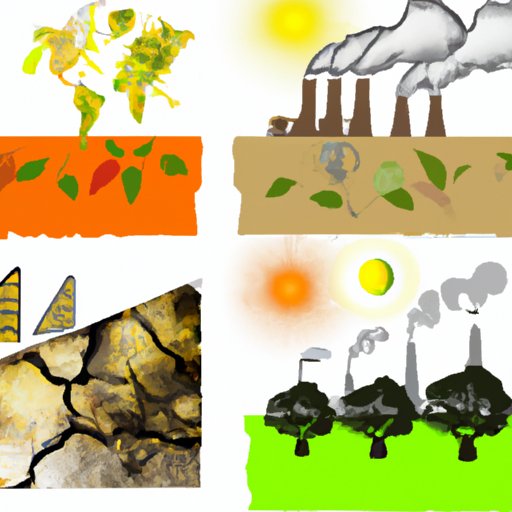Introduction
Global warming is a phenomenon caused by the burning of fossil fuels, deforestation, and other human activities that release large amounts of greenhouse gases into the atmosphere. These gases trap heat from the sun, resulting in rising temperatures and climate change around the world. The effects of global warming are far-reaching and can lead to extreme weather events, sea level rise, and the extinction of entire species. It is a serious problem that requires urgent action.
Increase Renewable Energy Use
One of the most effective strategies for combating global warming is to increase the use of renewable energy sources such as solar, wind, and hydropower. Renewable energy sources produce little or no greenhouse gas emissions and can provide a reliable source of power without depleting natural resources. In addition, they often have a lower cost than traditional energy sources.
Benefits of Renewable Energy
Renewable energy sources have many benefits, including:
- Reduced air pollution from burning fossil fuels
- Lower greenhouse gas emissions
- More reliable energy supply
- Reduced dependence on foreign oil
- Creating jobs in the renewable energy sector
Examples of Renewable Energy Sources
The most common types of renewable energy sources are:
- Solar energy – harnessing the power of the sun’s rays
- Wind energy – using turbines to capture the energy of the wind
- Hydropower – using dams and other structures to generate electricity from water
- Geothermal energy – using the Earth’s internal heat to generate electricity
- Bioenergy – using organic materials such as plant matter to generate electricity
Steps to Increase Renewable Energy Use
In order to increase the use of renewable energy, governments and businesses should take the following steps:
- Invest in research and development of new renewable energy technologies
- Offer financial incentives for individuals and businesses to switch to renewable energy sources
- Provide tax credits for renewable energy investments
- Require utilities to generate a certain percentage of their power from renewable sources
- Create policies that encourage the use of renewable energy
Improve Energy Efficiency
Another important strategy for reducing global warming is to improve energy efficiency. This means using less energy to achieve the same result, which can help reduce emissions and save money. By improving the efficiency of buildings, appliances, and vehicles, we can significantly reduce the amount of energy needed to power our lives.
Benefits of Improved Energy Efficiency
Improved energy efficiency has many benefits, including:
- Reduced energy consumption
- Lower utility bills
- Reduced greenhouse gas emissions
- Increased economic productivity
- Improved public health
Examples of Energy Efficiency Measures
There are many ways to improve energy efficiency, including:
- Installing energy-efficient appliances and lighting
- Improving insulation in buildings
- Using energy-efficient windows and doors
- Improving the efficiency of heating and cooling systems
- Using renewable energy sources
Steps to Increase Energy Efficiency
Governments and businesses can take the following steps to increase energy efficiency:
- Develop and implement building codes that require energy-efficient construction
- Offer incentives for installing energy-efficient appliances and lighting
- Provide technical assistance to help businesses improve their energy efficiency
- Implement energy-efficiency standards for appliances, vehicles, and other products
- Require utilities to offer energy-efficiency programs to their customers
Reduce Greenhouse Gas Emissions
Greenhouse gas emissions are one of the primary causes of global warming. Reducing emissions is essential if we want to slow down the process of climate change. There are many strategies for reducing emissions, ranging from changing our behavior to investing in new technologies.
Benefits of Reduced Emissions
Reducing greenhouse gas emissions has many benefits, including:
- Slowing the process of climate change
- Reducing air pollution
- Protecting public health
- Preserving natural resources
- Creating jobs in the green economy
Examples of Emission-Reducing Strategies
Some of the most effective strategies for reducing emissions include:
- Increasing the use of renewable energy sources
- Improving energy efficiency
- Reducing waste and increasing recycling
- Switching to electric vehicles
- Adopting sustainable agricultural practices
Steps to Reduce Emissions
Governments and businesses should take the following steps to reduce emissions:
- Set emissions reduction targets and monitor progress
- Implement regulations to limit emissions from industry and transportation
- Invest in research and development of new clean energy technologies
- Offer incentives for individuals and businesses to reduce emissions
- Educate the public about the importance of reducing emissions
Invest in Carbon Capture and Storage Technologies
Carbon capture and storage (CCS) technologies capture carbon dioxide from the air and store it underground. This could be an effective way to reduce emissions and slow down the process of climate change. However, CCS technologies are still in the early stages of development and require significant investment.
Benefits of Carbon Capture and Storage
The benefits of CCS include:
- Reduced emissions from power plants and other sources
- Improved air quality
- Reduced risk of climate change
- Increased energy security
- Creation of jobs in the CCS industry
Examples of Carbon Capture and Storage Technologies
Some of the most promising CCS technologies include:
- Bioenergy with carbon capture and storage (BECCS)
- Direct air capture (DAC)
- Carbon dioxide utilization (CDU)
- Enhanced oil recovery (EOR)
- Ocean iron fertilization (OIF)
Steps to Invest in Carbon Capture and Storage
In order to invest in CCS technologies, governments and businesses should take the following steps:
- Invest in research and development of new CCS technologies
- Provide financial incentives for companies to adopt CCS technologies
- Create policies to encourage the use of CCS technologies
- Develop regulations to ensure the safe storage of carbon dioxide
- Encourage the private sector to invest in CCS technologies

Increase Reforestation and Conservation Efforts
Reforestation and conservation efforts can help reduce emissions by absorbing carbon dioxide from the atmosphere and storing it in trees and soil. In addition, these efforts can help protect biodiversity, preserve natural habitats, and provide other environmental benefits.
Benefits of Reforestation and Conservation
The benefits of reforestation and conservation include:
- Reduced emissions from deforestation
- Protection of biodiversity and natural habitats
- Improved air and water quality
- Increased carbon storage in forests and soils
- Creation of jobs in the forestry and conservation sectors
Examples of Reforestation and Conservation Programs
Some examples of reforestation and conservation programs include:
- Planting trees in urban areas
- Creating protected areas and wildlife refuges
- Promoting sustainable forestry practices
- Restoring wetlands and other ecosystems
- Encouraging the use of alternative fuels
Steps to Increase Reforestation and Conservation
To increase reforestation and conservation efforts, governments and businesses should take the following steps:
- Invest in research and development of new reforestation and conservation technologies
- Offer incentives for individuals and businesses to participate in reforestation and conservation programs
- Provide funding for reforestation and conservation projects
- Create policies to protect forests, wetlands, and other natural habitats
- Educate the public about the importance of reforestation and conservation
Conclusion
Global warming is a serious problem that requires urgent action. Fortunately, there are many strategies we can use to address this problem, such as increasing the use of renewable energy, improving energy efficiency, reducing emissions, investing in carbon capture and storage technologies, and increasing reforestation and conservation efforts. By taking these steps, we can make a real difference in the fight against global warming.
(Note: Is this article not meeting your expectations? Do you have knowledge or insights to share? Unlock new opportunities and expand your reach by joining our authors team. Click Registration to join us and share your expertise with our readers.)
